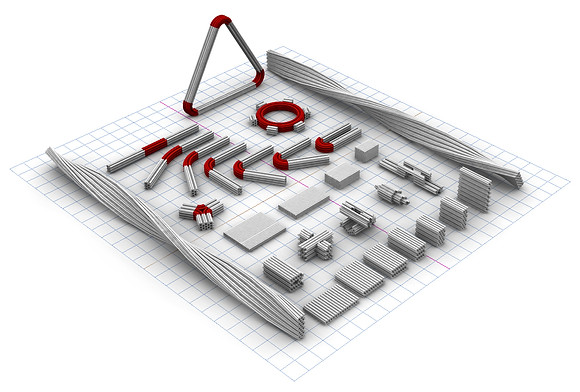DNA-Based Architectures
Structural DNA nanotechnology, a field launched by Ned Seeman in 1982, provides the foundation for most of our research efforts. Over the last four decades, the field has sustained exponential increases in the achievable complexity of DNA nanostructures. These advances have been been driven by successive introductions of key design paradigms into the field, such as multi-crossovers, tile-based assembly, and origami. We are greatly interested in elaboration of these themes for continuation of this exponential trend.

Multi-layer DNA origami developed in the Shih Lab.
Each underlying grid square
has dimensions 20 nm by 20 nm.
image credit Chenxiang Lin
Crisscross nanoconstruction
For nanoconstruction, DNA origami provides amazing all-or-nothing self-assembly, however size is limited by the length of the scaffold. Due to the susceptibility to mechanical shearing of long DNA, it is highly challenging to manipulate scaffolds longer than about 10 kb. In contrast, much larger structures can be achieved with DNA tile assembly, however a lack of strict seed-dependence leads to limited control over copy number and the co-existence of partial assemblies. We are developing a tiling strategy — crisscross polymerization — that combines the absolute scaffold-dependence of DNA origami with the unbounded size of tile/brick nanoconstructions. We envision crisscross assembly will play a key role in extending all-or-nothing DNA construction into the microscale by minimizing contamination from partial or incomplete structures. We have special interest in algorithmic crisscross assembly to achieve large structures from smaller numbers of unique building blocks.
Image credit Chris Wintersinger
Image credit Dionis Minev, Chris Wintersinger

Square tiles (i) versus hexagonal tiles (ii) versus crisscross slats (n=6) (iii). (iv) Slats may be arbitrarily extended to any positive integer n to increase coordination number.
Each binding domain in the abstract model is a half turn of DNA. Lower left, crisscross polymerization of ssDNA slats (blue x- and gold y-slats) as triggered by a DNA-origami seed (light green). Straight cylinders represent double helices. Right, negative-stain TEM images.

Key publications:
Wickham SFJ, Auer A, Min J, Ponnuswamy N, Woehrstein JB, Schueder F, Strauss MT, Schnitzbauer J, Nathwani B, Zhao Z, Perrault SD, Hahn J, Lee S, Bastings MM, Helmig SW, Kodal AL, Yin P, Jungmann R*, Shih WM*. Complex Multicomponent Patterns Rendered on a 3D DNA-Barrel Pegboard. Nat Commun. 11, 5768, 2020. [zip]
Minev D*, Wintersinger CM*, Ershova A, Shih WM. Robust Nucleation Control via Crisscross Polymerization of Highly Coordinated DNA Slats. Nat Commun. 12, 1741, 2021. [zip]